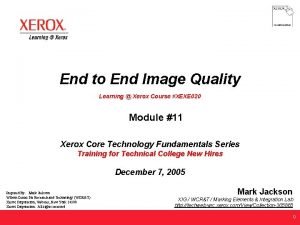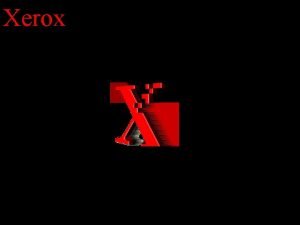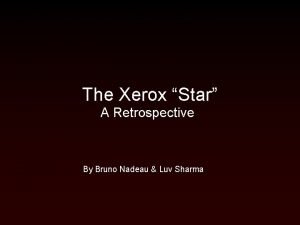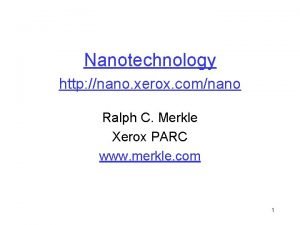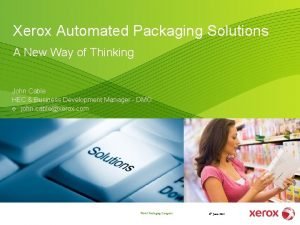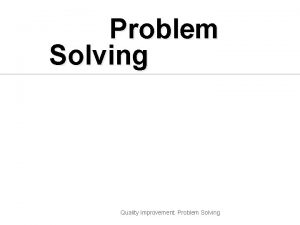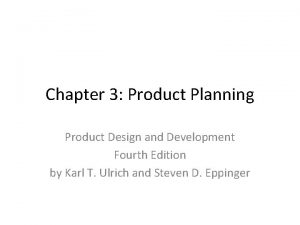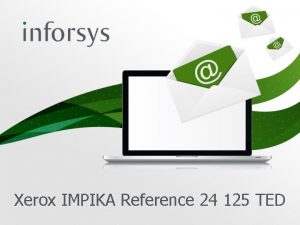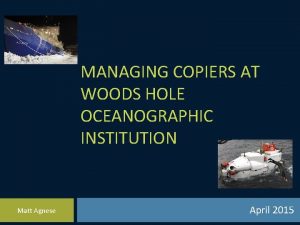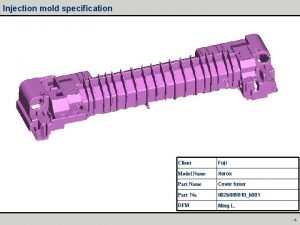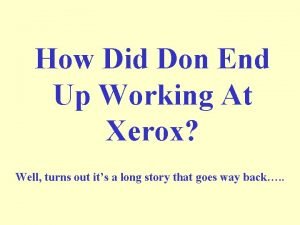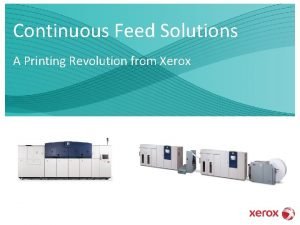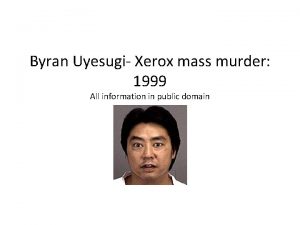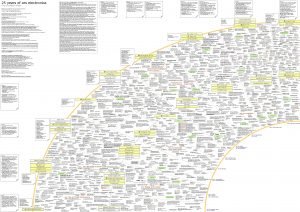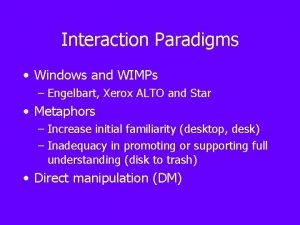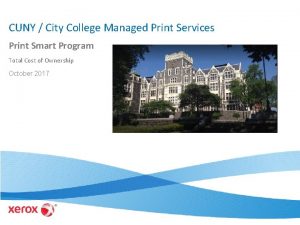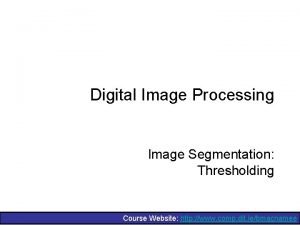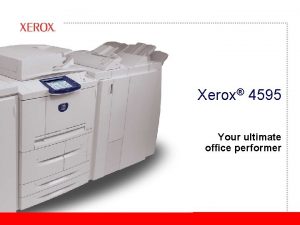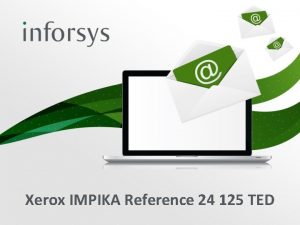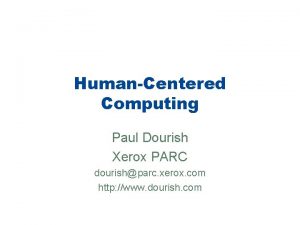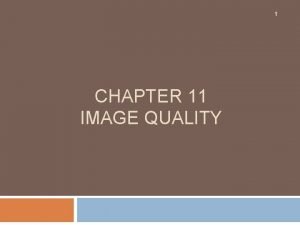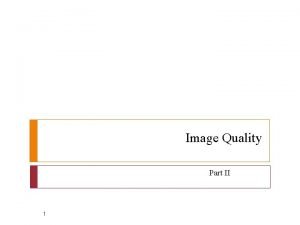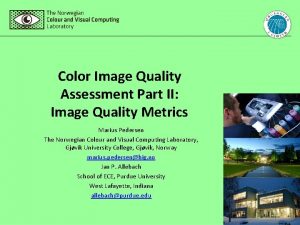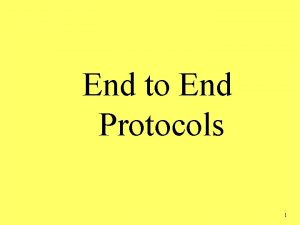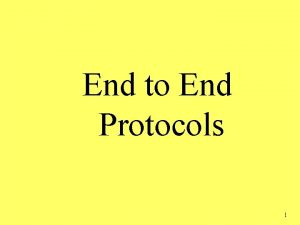End to End Image Quality Learning Xerox Course


































- Slides: 34

End to End Image Quality Learning @ Xerox Course #XEXE 020 Module #11 Xerox Core Technology Fundamentals Series Training for Technical College New Hires December 7, 2005 Prepared By: Mark Jackson Wilson Center for Research and Technology (WCR&T) Xerox Corporation, Webster, New York 14580 Xerox Corporation. All rights reserved Mark Jackson XIG / WCR&T / Marking Elements & Integration Lab http: //techweb. wrc. xerox. com/View/Collection-305865 0

Participant Information Welcome to module #11, End to End Image Quality, presented by Mark Jackson. This module is a 2. 0 hour session. To receive credit for this learning event, you must have registered in Learning @ Xerox. If you attended this session but did not register, contact the Xerox Engineering Center Learning Office at 8*222 -1286. A Sign-In Sheet will be available at each session. You must sign in for each module in the series to receive credit for this learning event. A Xerox Core Technology Fundamentals Evaluation will be forwarded via e-mail after today’s session. Please complete and submit shortly after the completion of this session. Thank you! December 7, 2005 – End to End Image Quality – Mark Jackson 1

Biography Mark Jackson Mark is currently a principal scientist engaged in marking process modeling and analysis in the Marking Process and Controls Integration area of the Wilson Center’s Marking Elements and Integration Lab. Mark graduated from Caltech in 1969 majoring in physics and spent seven years in condensed matter physics at the University of Illinois, receiving a Ph. D. Mark completed postdoctoral work in France at CNRS Bellevue and the CEA facility at Saclay, near Paris, and three years in Cornell’s Department of Materials Science and Engineering. His work included measurement of ionic conduction at high hydrostatic pressure, of the isotope effect for diffusion in metals (tin in the beta phase of titanium for his Ph. D thesis) and organic crystals, and of electromigration in metals; and measurement and theory of nonelastic deformation in solids and thin films. Mark joined Xerox in 1980 in the Transfer / Charge Engineering Area and has continued to work in the successor technology and research / technology organizations. At Xerox Mark has worked on transfer, process controls, system engineering, and image quality modeling, generally for preproduct development (or product development support) with focus on xerographic process physics, sensor development, marking engine architecture, and color science. Mark is the subject matter expert for the Amber modeling environment and for the Image Quality Modeling Facility. Find out more about Mark at: http: //www. wrc. xerox. com/~mjackson/. December 7, 2005 – End to End Image Quality – Mark Jackson 2

Overview Motivation Understanding and representing subsystem effects n nonlinearity n nonlocality n noise Sharpness and noise A subsystem-by-subsystem tour Concluding remarks turn on Notes Page (View menu) in Power. Point to see annotations December 7, 2005 – End to End Image Quality – Mark Jackson 3

What Determines Image Quality? Customer Preference* Spectral Marketplace Reflectivity Pattern Program IQ Expert SIR Scale* R( , x, y) Instrument Analytical Metric* Output Document *see http: //moire. wrc. xerox. com/CIQS. html December 7, 2005 – End to End Image Quality – Mark Jackson 4

Image Flow in the Xerographic IOT Input Image (bitmap) Imager Photodischarge Aerial Image (exposure) Latent Image (“voltage”) Development Developed Image (mass/area) Transferred Image (mass/area) Fusing Fused Image (spectral reflectivity) December 7, 2005 – End to End Image Quality – Mark Jackson 5

Continuous-Tone Response: The Jones Plot system input (Din) is mapped through the subsystem blocks Dout each block represents the large-area contone response of a subsystem TRC Fusing the result is the system Tone Reproduction Curve for continuous-tone input Din mg/cm 2 Din Transfer Exposure fold plane mg/cm 2 erg/cm 2 mg/cm 2 Lotus Mode 2 Nominal @ Setup 1 -30 -1979 R. E. Grace Development V Charge / PR December 7, 2005 – End to End Image Quality – Mark Jackson 6

The Jones Plot: Illustrative But Limited Illustrates why a contone process (like xerography) must still employ halftoning of some sort n limited dynamic input range (light-lens issue) n high sensitivity to noise (light-lens and IOT issue) Represents response to only one type of input n separate analyses are required for different types of lines, and for different frequency halftones if these are to be considered Disregards many factors critical to system design n temporal and spatial variation of responses n subsystem interactions other than the image n failure boundaries (e. g. fix level) December 7, 2005 – End to End Image Quality – Mark Jackson 7

The Complexity of Subsystem Effects Xerographic subsystems (real-world marking subsystems in general) are not simple n most subsystems are nonlinear in their large-area response (see Jones plot) n most subsystems are nonlocal on a length scale (tens of microns) that affects image rendition n most subsystems introduce unwanted signal variation (noise) on several significant length scales Quantitative modeling of, and semiquantitative reasoning about, a chain of nonlinear, nonlocal, noisy subsystems is a daunting prospect December 7, 2005 – End to End Image Quality – Mark Jackson 8

The Complexity of Subsystem Effects Fortunately past work has shown that separating the nonlinear and nonlocal subsystem effects (at least) can yield a good approximation of some subsystem behavior We will proceed as if these effects were separable n an adequate approximation for many quantitative calculations na framework for thinking about system behavior na potential trap for the unwary. . . December 7, 2005 – End to End Image Quality – Mark Jackson 9

Subsystem Spatial (Nonlocal) Effects LTF Photoreceptor PIDC* MTF LTF IMB Development MTF Light-Lens Optics MTF Transfer *neglecting charge spreading If linear, represent as modulation transfer function (MTF) n hard to measure n inferential techniques may be used, but these assume separability and (usually) some parameterized form for the MTF The composition with contone response applied locally (LTF) is directed by physical insight (and past studies) confirmed if possible by experiment December 7, 2005 – End to End Image Quality – Mark Jackson 10

Subsystem Image Noise Sources slowly* varying noise MTF rapidly* varying noise LTF functional and critical parameters can be considered constant over image MTF LTF noise f(input, random) (random) *over spatial effect length scales This is arguably the hardest remaining problem in color and other high IQ systems Subsystem and system characterization is challenging “Macrouniformity” is generally a “slowly varying” problem Noise separability is an approximation to be tested December 7, 2005 – End to End Image Quality – Mark Jackson 11

The Importance of Sharpness Variation in background and solid levels is small Color variation is primarily driven by dot size modulation, and is most visible in highlight and midtones If a sharper image can be maintained: n less dot modulation will result from subsystem variation n microuniformity defects should be reduced Caution: restoring lost sharpness may cause net harm n variability in sharpening function is a likely strong noise source solid Δedge midtone Δedge Δsignal background December 7, 2005 – End to End Image Quality – Mark Jackson 12

How Much of the Image Is Edge? coarse 50% halftone fine 50% halftone As halftone frequency increases image contone For fixed sharpness, grey area scales with dot perimeter n perimeter is the friend of noise and the enemy of stability December 7, 2005 – End to End Image Quality – Mark Jackson 13

TRC As A Function of Halftone Frequency December 7, 2005 – End to End Image Quality – Mark Jackson 14

Following Images Through the IOT Simplified high-quality xerographic engine n tools: http: //techweb. wrc. xerox. com/View/Collection-50 Two monochrome (black) images: n a 2 -pixel perpendicular (cross-process, fast-scan) isolated positive line n a 40% halftone, using a 141/in 45 -degree design using PWPM at 2 bits/pixel 600 spi flying-spot LD ROS n 31 μm fast-scan x 38 μm slow-scan spot Some additional liberties taken n charge spreading in the photoreceptor neglected (but net effect captured in development treatment) n no explicit noise terms December 7, 2005 – End to End Image Quality – Mark Jackson 15

The Input Bitmap ROS fast scan process 2 -pixel line 40% 141/in 45 o halftone on 2/3 on 1/3 on off December 7, 2005 – End to End Image Quality – Mark Jackson 16

The Aerial Image erg/cm 2 2 -pixel line 40% 141/in 45 o halftone December 7, 2005 – End to End Image Quality – Mark Jackson 17

Photodischarge The PIDC (typical Galaxy) is applied point-by point This neglects charge spreading in the transport layer n not readily measured, so (historically) lumped with development n inseparably nonlinear, so not easily fit into a simple analysis n representative line calculations suggest effects which would significantly impact TRC if similar in halftones Noise due to ROS or photoreceptor is generally “slowly varying” n images rendered elsewhere on page (or in time) will shift up or down December 7, 2005 – End to End Image Quality – Mark Jackson 18

The Latent Image “V” (C/F) 2 -pixel line 40% 141/in 45 o halftone December 7, 2005 – End to End Image Quality – Mark Jackson 19

Charge Spreading in Photoreceptor: Discharge of a single pixel line* ROS profile Injected charge profile Discharged profile Input FWHM=34 Injected FWHM=44. 1 Discharged FWHM=58. 7 Quantum Eff. E 1/2 PR thickness=30 * S. Maitra, P. Ramesh and S. Jeyadev, Impact of ROS Photoreceptor Interactions on Digital Electrophotography, X 9600362, 1996. http: //techweb. wrc. xerox. com/Get/File-3671 December 7, 2005 – End to End Image Quality – Mark Jackson 20

Development Spatial Effects Development technologies exhibit the widest array of spatial behaviors of any xerographic subsystem n classical IMB is well described (Hamerly, mid-1970 s) by an edge-enhancing MTF followed by an LTF n CMB (1075 and variants) requires a softer MTF; isolated lines need a cleaning field offset (Maltz and Szczepanik, early 1980 s) or LTF adjustment (Davidson, late 1980 s) n non-xerographic technologies may differ in detail (e. g. increased sharpness with LID) but probably not broadly For the following simulation a simplification appropriate to HSD for halftones and narrow lines was used n fairly sharp MTF n some cleaning field offset December 7, 2005 – End to End Image Quality – Mark Jackson 21

The Developed Image mg/cm 2 2 -pixel line 40% 141/in 45 o halftone December 7, 2005 – End to End Image Quality – Mark Jackson 22

Noise in Development “Slowly varying” development noise is common n spatial (particularly in donor roll systems) n temporal (due to, e. g. , changes in materials state) The nonlinear LTF can overcome even an MTF without edge enhancement, and sharpen the image n variability of the latent image still moves the resulting edges n and variation in the onset of development (e. g. Vd 0) is a strong noise driver “Rapidly varying” development noise is often a problem n particulate and other microscale effects cause line edge noise and halftone graininess n sharp latent images reduce the area in which this may occur December 7, 2005 – End to End Image Quality – Mark Jackson 23

Powder Cloud Development Such systems have additional, highly complex effects due to long-distance interactions Example: Lakes HSD and HJD (Davidson, 1994) http: //www. wrc. xerox. com/~mjackson/IQMF/IOT/dev. MTF 2. pdf December 7, 2005 – End to End Image Quality – Mark Jackson 24

Normal Behavior of Transfer Well described by LTF followed by MTF (Maltz, 1981) n constant over conditions within latitude band for transfer n smaller toner is better (a few big ones hurt significantly) n substrate is significant (smoother is better? ) Moderate loss in resolution Selective rejection of background actually helps IQ 100% TE TMA 50 -100 μm DMA spread function December 7, 2005 – End to End Image Quality – Mark Jackson 25

The Transferred Image mg/cm 2 2 -pixel line 40% 141/in 45 o halftone December 7, 2005 – End to End Image Quality – Mark Jackson 26

Noise in Transfer “Slowly” (or occasionally “rapidly”) varying transfer performance can cause a number of IQ defects n tenting due to debris or image adjacency, substrate roughness or large-scale nonflatness can cause airgaps upoor or erratic LTF due to air breakdown-limited field reduction uincreased spreading / toner scatter n excessive tribo, wide tribo distributions, high toner-toner cohesion within the developed image may cause erratic LTF performance n these failures are difficult and unrewarding to model; they must be engineered away December 7, 2005 – End to End Image Quality – Mark Jackson 27

Fusing: From TMA to Spectral Absorption But that’s not the whole story. . . December 7, 2005 – End to End Image Quality – Mark Jackson 28

The Image-Paper Interaction For thin images, light is reflected by the substrate In paper some fraction of the light diffuses laterally (perhaps 100 μm in some papers) This lightens edges and darkens background near images - the Yule-Nielsen effect Limiting factor on edge sharpness for perfect rendering light color near edges air light color outside edges toner paper December 7, 2005 – End to End Image Quality – Mark Jackson 29

The Observed Image CIE L* 2 -pixel line 40% 141/in 45 o halftone December 7, 2005 – End to End Image Quality – Mark Jackson 30

Concluding Remarks “Image flow through the subsystems” is a useful way to reason about system behavior n for the system designer / integrator / engineer n for the subsystem engineer, who ought to understand the context of his or her subsystem It has been usefully quantified for real program applications n IQ centerline design, system capability estimation, subsystem allocations, process controls simulation, IQ problem analysis n Columbia, Sunray, Lakes F 2/F 3, Tigris, Aldebaran, Sfida, Stirling / Sorcery, i. Gen 3, Rodan December 7, 2005 – End to End Image Quality – Mark Jackson 31

Questions & Answers ? ? December 7, 2005 – End to End Image Quality – Mark Jackson 32

End of Session Reminder! To Participants: Please Sign In Before You Leave. This ensures receiving credit in L @ X for this training module. Evaluation. After today’s learning event, an Evaluation will be forwarded to you by e-mail. Please complete the Evaluation and submit within a day or two. Your feedback enables us to make continuous improvements in this training. Thank you for your participation! December 7, 2005 – End to End Image Quality – Mark Jackson 33
 Learning@xerox
Learning@xerox Xerox mission
Xerox mission Sketchpad
Sketchpad Xerox nano
Xerox nano Fuji xerox
Fuji xerox Purdue xerox
Purdue xerox Xerox taleo
Xerox taleo Parnazol
Parnazol Xerox problem solving process
Xerox problem solving process Product platform
Product platform Xerox impika
Xerox impika Xerox copiers marin
Xerox copiers marin Injection part name
Injection part name Xerox 6085 workstation
Xerox 6085 workstation What is a continuous feed printer
What is a continuous feed printer Bryan uyesugi
Bryan uyesugi Elsa mittmannsgruber lebenslauf
Elsa mittmannsgruber lebenslauf Xerox alto
Xerox alto Xerox valence
Xerox valence Xerox smart cities
Xerox smart cities Cuadro comparativo e-learning b-learning m-learning
Cuadro comparativo e-learning b-learning m-learning What is half brick wall
What is half brick wall Course number and title
Course number and title Chaine parallèle muscle
Chaine parallèle muscle Perform quality assurance
Perform quality assurance Quality management pmp
Quality management pmp Pmp gold plating
Pmp gold plating Quality assurance model in nursing
Quality assurance model in nursing Quality improvement vs quality assurance
Quality improvement vs quality assurance Concepts of quality
Concepts of quality Gurus of total quality management
Gurus of total quality management Quality is free
Quality is free What is tqm
What is tqm Gonzalez
Gonzalez Hbs eoc practice test
Hbs eoc practice test
